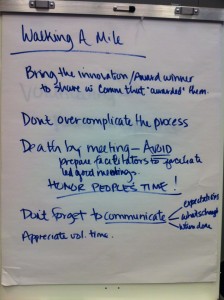 The presentation Peggy Hoffman, Eric Lanke, and I recently gave at ASAE’s Marketing, Membership and Communications Conference on volunteer engagement was about learning to manage volunteers by being a volunteer, aka “Walking a Mile in Their Shoes.”
The presentation Peggy Hoffman, Eric Lanke, and I recently gave at ASAE’s Marketing, Membership and Communications Conference on volunteer engagement was about learning to manage volunteers by being a volunteer, aka “Walking a Mile in Their Shoes.”
I addressed this topic by sharing my story of volunteering with the National Capital Area Food Bank as a means of illustrating the following points:
- Learn by doing: What can we learn about what works, what doesn’t work, and what our volunteers need to be successful by volunteering ourselves?
- Have a defined task: Do your volunteers know exactly what you need them to do?
- Create clear expectations: Do your volunteers know what constitutes success at their volunteer tasks, and how they’ll know when they’re done?
- Match skills to opportunities: Do you work to find out what your volunteers are really good at and really passionate about before matching them with assignments?
- Ensure their time is well spent: Do you respect your volunteers’ time?
- Show that their efforts are appreciated: Do you make sure your volunteers see the impact of their work? Do you report back on what happened with the ideas and recommendations they provided?
Per our session design, I then asked attendees to apply those principles to answering the following question: What have you learned from your own experiences as a volunteer that you can bring to your role as a manager of volunteers to improve their experience with your association?
Our session participants came up with some great advice:
One woman talked about her experiences as a soccer mom to point out that we need to be careful not to over-complicate or over-manage the process. If people want to volunteer, make it easy for them to contribute and get involved. Be ruthless about stripping away any unnecessary hurdles.
Another attendee warned us, based on her time serving on the PTA, to beware death by meetings. It can be hard for 100% volunteer organizations to find good facilitators, but that’s critical to respecting your volunteers’ time. When people are forced to waste time in long meetings that go nowhere and accomplish nothing, they quickly become disillusioned and disengaged.
One participant referenced phone banking to raise money for a college alumni association to illustrate the importance of communicating with your experienced volunteers. If processes, procedures, goals, policies, etc. change, new volunteers won’t know any different, but your experienced volunteers will be confused, and, again, potentially turned off to volunteering for your organization.
What have you learned from your own experiences volunteering that you can apply to your association work to help you do better by your volunteers?